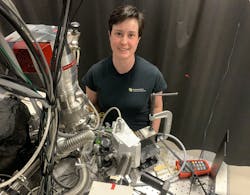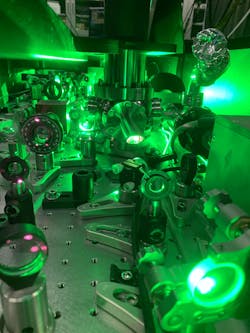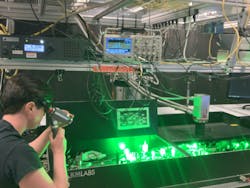High-harmonic generation light probe reveals spin dynamics within a Heusler compound
A team of JILA (formerly known as the Joint Institute for Laboratory Astrophysics) researchers at the University of Colorado–Boulder, led by Professors Margaret Murnane and Henry Kapteyn, are exploring the electron spin dynamics within metals. These spin dynamics are governed by quantum mechanics and aren’t remotely well understood—especially at ultrafast timescales.
The key to demystifying it? Pulsed femtosecond lasers and EUV HHG enable the researchers to measure and manipulate spin dynamics with femtosecond precision, which may redefine the future of what’s possible for electronics and data storage.
For this work, the JILA team and their collaborators from Sweden, Greece, and Germany delved into the spin dynamics of a Heusler compound, Co2MnGa, which is a mixture of metals that behave like a single magnetic material. One intriguing property of this compound is that it’s an insulator for downward-aligned spins, but a conductor for upward-aligned spins.
By turning EUV HHG into a light probe (see Fig. 1), the researchers can track the dynamics of the spins inside the compound after exciting it with a femtosecond laser, which cause the sample to change its magnetic properties. The ability to tune the color of the EUV HHG probe light makes it possible to accurately interpret spin dynamics.
“I joined the lab of Margaret Murnane and Henry Kapteyn because they’re doing beautiful research that brings the high-energy photon capabilities of a synchrotron light source to a tabletop experiment,” says Sinéad A. Ryan, a JILA graduate student (see Fig. 2). “I was excited to be part of this particular project—it was inspired by interesting previous results of our research group and others, which showed that spins can be transferred between elements in a magnetic alloy on very short timescales.”
EUV high-harmonic probes
To delve into the spin dynamics of Co2MnGa, Ryan and colleagues created EUV high-harmonic probes by focusing 800 nm laser light into a tube filled with neon gas, in which the laser’s electric field rip the electrons away from their atoms, and the electrons snap back.
When electrons snap back, it’s akin to rubber bands released after being stretched. This creates purple bursts of light at a higher frequency (and energy) than the laser that kicks them out. Ryan tuned these bursts to resonate with the energies of the cobalt (Co) and the manganese (Mn) within the sample, and measured element-specific spin dynamics and magnetic behaviors within the material that the team could further manipulate.
“In the Co2MnGa sample, the magnetism is produced by the bonding of Mn and Co atoms,” explains Ryan. “By tuning the color of the driving laser by small amounts, I was able to scan the high-harmonic comb in a range of energies all the way from 45 eV to 73 eV. This energy-tunable high-harmonic probe allows me to measure specific resonances that come from the magnetism of Mn and Co.”
By individually tracking how these resonances change when excited by a pump laser, Ryan could explore how the magnetism of the Co and Mn change as spins are excited between them. Previous studies of these spin transfer effects only measured each element in the alloy at one or two energies. But this new driving laser tunability enables her to measure dozens of energies across the resonances of Co and Mn.
“It means we can build a fuller picture about how spins move throughout the materials during and after the pump laser excitation,” Ryan says. “These experimental results were combined with extensive theoretical analysis from our collaborators. Furthermore, by increasing or decreasing the amount of fluence in the pump laser, I was able to change the balance of competing effects induced by the pump laser excitation.”
The most surprising moment for the team occurred when they did a bit of laser maintenance, which ended up slightly shifting the wavelength of their driving laser and also slightly altering the energies of the high harmonics. “I retook some data on the Co2MnGa sample and was shocked to see the measured signal from the sample was completely different. This is when I realized the dynamics of the sample are very sensitive to the probing energy,” says Ryan.
Ryan discovered she could tune the harmonic energies by manipulating the seed pulses into their amplifier (see Figs. 3 and 4). “It felt very exciting to be able to see the material’s behavior at 64 different probing energies—all with excellent time resolution,” she says.
And it was a research first. Then, Ryan added fluence dependence on top of it, and it was another first because no one else had the combination of probe tunability and timing stability to make this type of comprehensive dataset.
“Our biggest challenge was learning how to fully tune the harmonic energies by shifting the driving laser wavelength, and then achieving good enough stability to run the experiment within these detuned energy regimes,” says Ryan.
Spin effects revealed
The team’s experiment revealed that by tuning the power of the excitation laser and the photon energy of their HHG probe, they could determine which spin effects were dominant at different times within Co2MnGa.
They compared their measurements to a complex computational model—time-dependent density functional theory (TD-DFT)—to predict how a cloud of electrons within a material will evolve when exposed to a variety of inputs.
Mohamed Elhanoty, a Ph.D. student who visited JILA from Uppsala University, used TD-DFT to compare theoretical models of spin changes to the team’s experimental data and found agreement between the model and the experimental data, thanks to three competing spin effects within the Heusler compound.
Elhanoty discovered that the spin flips were dominant on early timescales, and then spin transfers became more dominant. As time progresses, more demagnetization effects take over and the sample demagnetizes.
Spin flips happen within one element of the sample as the spins shift their orientation (up vs. down). But spin transfers happen within multiple elements. In this case, the cobalt and manganese, as they transfer spins between each other. This causes each material to become more or less magnetic as time progresses.
Figuring out which effects were dominant at which energies and times gave the researchers a better understanding of how spins can be manipulated to give materials more powerful magnetic and electronic properties.
Fastest manipulations of magnetism
The spin transfer effects the team is researching are some of the fastest known manipulations of magnetism—as fast as the laser pulse itself, at the few-femtoseconds timescale.
“We hope that in the future these techniques will be used to design spintronic devices that can be controlled via pulsed lasers, which could create very fast and efficient devices,” says Ryan.
Ryan and colleagues are currently working on a follow-up study to compare the experimental measurements from this material and other similar alloys. “This future study will include new theoretical insights from the theory team at the University of Uppsala led by Mohamed Elhanoty,” she says.
FURTHER READING
S. A. Ryan et al., Sci. Adv., 9, 45 (Nov. 10, 2023); doi:10.1126/sciadv.adi1428.
About the Author
Sally Cole Johnson
Editor in Chief
Sally Cole Johnson, Laser Focus World’s editor in chief, is a science and technology journalist who specializes in physics and semiconductors.





